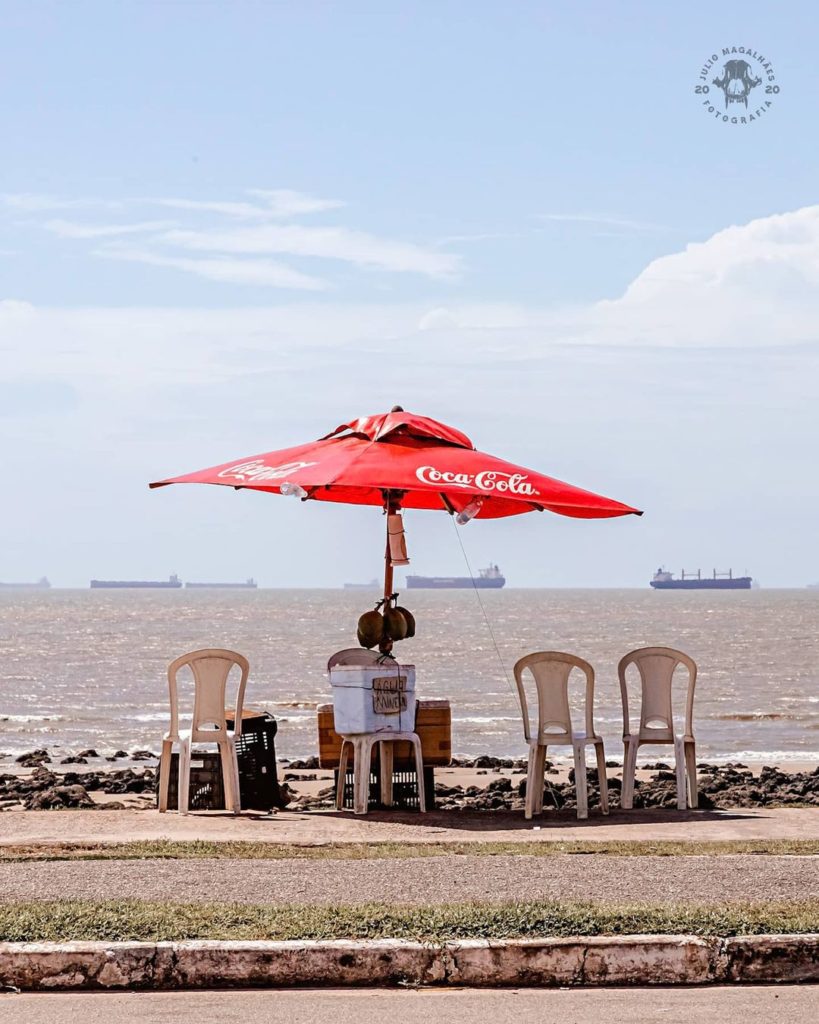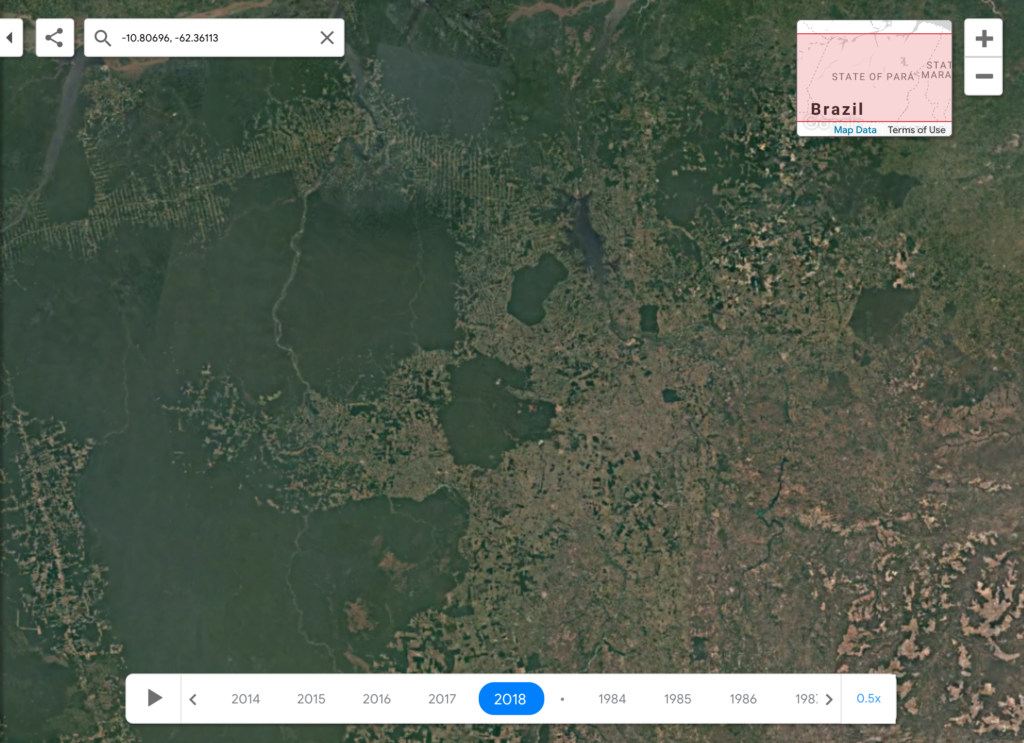Traveling between São Luís (Maranhão) and Parauapebas (Pará) can show us the advancing of the unsustainable practices entering the Amazon. This moment of the (online) journey is a time for reflection.
Author: Ana Rosa
Leia em português.

Still on the Island
Regardless of the only few trains crossing the Brazilian territory, it’s possible to continue our trip around the Amazon by rail. Last month we visited São Luís, the capital of Maranhão, entering the Amazon area via its East. The city is located on the coast and, in addition to the beautiful beaches, it’s also home to a port connected with the whole world. Large ships are constant characters on the horizon of the main beaches of the island.






The sea terminal of Ponta da Madeira, in São Luís, connects the minerals taken from the region of Carajás to different parts of the globe. Until it gets to the port, it is transported by trem da vale (this is a common term used by locals referring to trains that transport ore mined by Vale S.A., the largest mining company in Brazil). Besides transporting minerals, this same railway line is used as a passenger train that connects São Luís – MA (“Anjo da Guarda” station) to Parauapebas – PA three times a week in each direction.
This train takes us through two of the regions Meli has been focusing on: the east of Maranhão and southeast of Pará. In this area, the well known “Arc of Deforestation” is very clear. For a good part of the trip the landscape is composed of pastures and monoculture farms of eucalyptus and soy. We are on the frontier where unsustainable practices have crept into the Amazon.
Check how the deforestation developed in the area during the last decades:
1984
2000
2018



The amazonian frontier
A conversation with professor Evandro Medeiros allows us to clearly understand this region as an area of frontier. Professor Evandro teaches at Federal University of South and Southeast of Pará (Universidade Federal do Sul e Sudeste do Paraná), Unifesspa, and is one of the creators of FIA – Amazonian International Festival of Frontier Cinema, the FIA Cinefront*. His personal experience with Vale puts him in a privileged position to understand the region’s conflicts as he was prosecuted by Vale for protesting on its railroads. While demonstrating in a free circulation area on the rails of Estrada de Ferro Carajás with 30 other people in solidarity to the victims of the mining disaster of Mariana-MG (a mining dam which was owned by Samarco, a company controlled by Vale and BHP Billiton) he was appointed as being the leader of a group that allegedly obstructed and disturbed the services of the railroad. After almost five years of legal battle, the case was won by the professor and closed by the Brazilian law.
We could expect this to be an isolated case, but Vale has already prosecuted over 170 people involved in demonstrations against the consequences of the company’s activities in Pará and Maranhão. These prosecutions happen especially when the demonstrations obstruct the railroad, even if symbolically.
As professor Evandro Medeiros remembers, “public authorities in the city use sentences like ‘the train that takes riches, brings poverty’ to justify the unreasonable proposal of the legislators of the city of Marabá-PA to forbid the arrival, disembarking and entrance of migrant populations in the city through the trains on the Carajás Railways (Estrada de ferro de Carajás). Despite the despicable political interests that such sentences express”, Evandro continues, “deep down there was and there still is some truth to them: the activity of exploiting and exporting minerals in this area of the eastern Amazon creates social and environmental impacts and contradictions whose seriousness cannot be hidden: from the hole and forest devastations that will be left of the open mine to the violence and violation of rights of the poorer (landless, homeless, jobless, etc), in a scenery of demographic explosion and disorganized urban growth of cities with no infrastructure, services and jobs that make this region’s Human Development Index plummet.
* I would like to use the opportunity to recommend the film Pureza, one of the highlights of this year’s festival.

The environment
Medeiros also affirms that the construction of the railways “until recently was made with wood sleepers from the finest amazonian woods taken from thousands of deforested trees, information confessed by a former employee of Vale SA who worked in the maintenance of the rails”. The professor continued sharing this conversation, “he also told me that the change was not made because of some ecological responsibility of the company, but because they recognised that the murder of Sister Dorothy Stang, in February 2005, would capture the attention of the world for forest deforestation and, consequently, this attention would end up arriving to the activities of the mining company”.
The railroad goes through indigenous territories, quilombos and 22 conservation units. The impacts to the fauna and flora of preserved areas within a region with so much deforestation include consequences to the surrounding communities, such as noise and death of animals who are run over by the trains.
To bear the increase in the amount of minerals to be transported, supplying the global demand for metals, the railway is being duplicated. A large part of the route has already been duplicated and the rest may happen because of a concession of a Licence for Installation (Licença de Instalação – LI) given by IBAMA in 2012. But the railroad goes through the indigenous territories of Mãe Maria (Pará) and Carú (Maranhão) and any constructions in these areas are submitted to specific legislation. That is why the duplication was authorized in Carú only on december 4th 2015 and is still being negotiated in Mãe Maria.
Within and outside indigenous territory, the passage of open wagons full of minerals leaves a trail of dust where it passes. This opens doors to possible contaminations of areas close to the rails, including rivers and lakes. In places such as Piquiá de Baixo, families suffer from the iron ore and crude iron waste coming from the local steelmakers.

On the margins
Evandro Medeiros remembers that thousands of people living in poor communities on the margins of the Carajás Railway are impacted by the sound pollution.

According to the professor, constructions resulting of the duplication of the railroad resulted in “communities being isolated and populations having their free transit obstructed because of the duplication of the railroad; streets and house yards in many places suffering with floods because of water obstruction resulting from the security walls of the railroad; viaducts being built with the disrespect of living areas and generating one way entrances to neighborhoods; residents having had their houses destroyed because of the trepidation caused by the increase in the passing of cargo trains carrying more than 300 wagons and measuring 3,5km.”
Those who make this route by train, even if only online, are left to wonder about the impacts suffered by the region in the past decades.
Your donation can have a positive impact on the world!
Subscribe to receive our Newsletter!
Find us also at Linkedin, Facebook, Twitter or Instagram
www.meli-bees.org
❤️


One Reply to “Amazon by Rail”